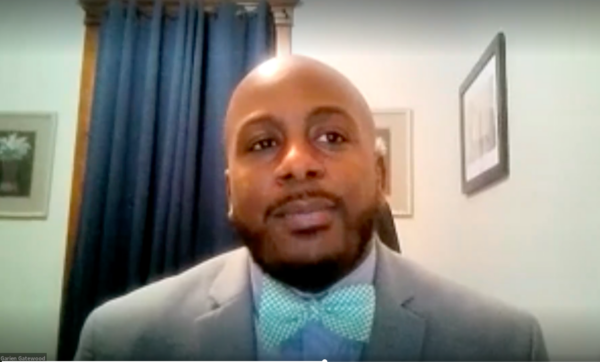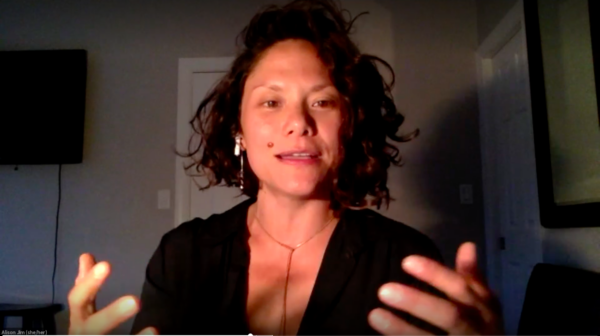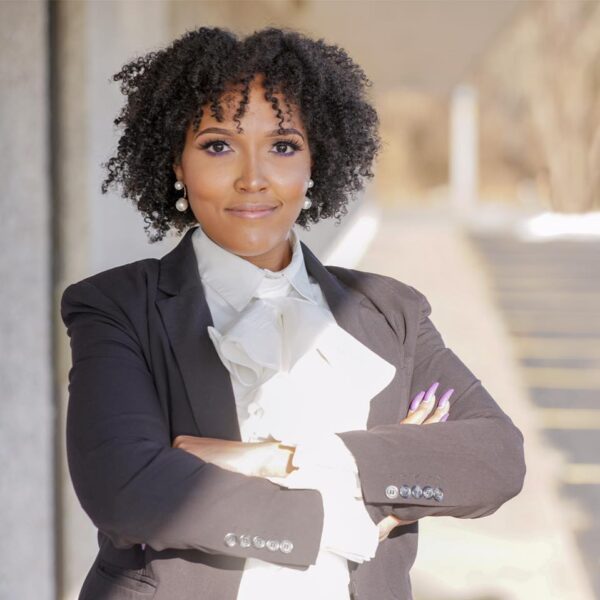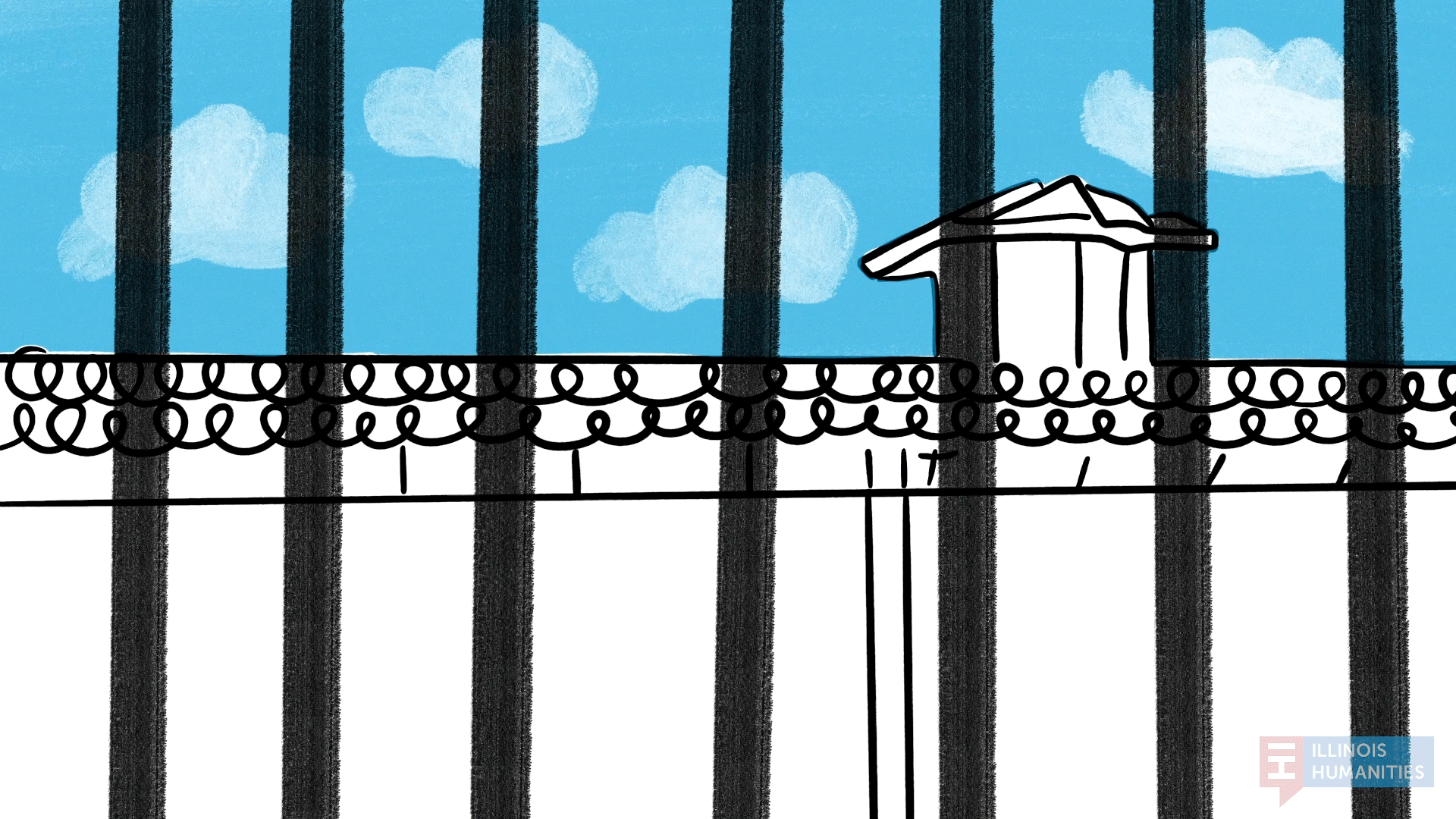In the fall of 2021, Illinois Humanities’ Envisioning Justice initiative hosted video premieres and community dialogues celebrating the release of our Visions of Justice series, produced in partnership with VAM STUDIO. Visions of Justice explored the far-reaching impacts of mass incarceration in Illinois by asking contributors around the state how they envision a just society and what we would need to do to achieve their vision. In addition to the videos produced for the series, seven panel discussions and one facilitated community dialogue were held over the course of an eight-part event series in communities across Illinois, namely: Bloomington-Normal, Carbondale, Chicago, Decatur, East St. Louis, Galesburg, and Urbana-Champaign, leading to a final statewide event, Visions of Justice: Illinois.
Contributors, both to the videos and to the events, came from a wide range of backgrounds and career paths, including social workers, artists, attorneys, organizers, and historians—approximately half of whom had spent time in jail or prison in their lifetime. In Illinois, we’re fortunate to have a robust network of community advocates and activists from all of these fields and more, each of whom struggles every day for a just future for our state. Even those featured in Visions of Justice who were unable to join us for the premieres, particularly our currently incarcerated contributors (check out this blog post for more information about Visions of Justice: Galesburg) were palpable presences in the conversations we shared over the course of the eight events.
Definitions and images of justice differ from person to person—I learned that lesson continually throughout this project. But what became stark over a month and a half of Visions of Justice panel discussions were the points of overlap between what contributors described in their home communities. To be sure, mass incarceration is a hyper-local phenomenon that affects different areas in locally specific ways. But when the repercussions of a trauma such as mass incarceration harm disparate communities in virtually the same ways, with almost identically damaging results, these similarities illustrate structural problems that exceed the bounds of any one town or city.
Here’s a roundup of what our panelists had to say on four points of overlap between Illinois communities featured in Visions of Justice.
Mass incarceration is not a naturally or randomly occurring phenomenon. Rather, it happened and continues to happen by design.
“Think about all of the mortgages Black and Brown kids from Chicago paid for people in Carbondale, for people in Harrisburg. So when you think about the structure of that where you take Black and Brown kids from the West Side and South Side of Chicago and ship them all around the state, what is your purpose? It is simply for the economic development of those communities. That’s what it boils down to. You don’t see people fighting to get people incarcerated, you don’t see those representatives fighting to have people who are incarcerated voting in their district, but they do want them counted in their districts so they can get resources.”
—Garien Gatewood (Visions of Justice: Illinois)

“I think it’s really important, when we talk about mass incarceration, to understand that it wasn’t an accident that this happened. This was the US government’s political response to the Black freedom movement and essentially all of the movements of the ‘60s and ‘70s, which had shaken the governance of America to its core…Mass incarceration was a political tool to essentially lock up the people who had been demanding fundamental change….The foundations for mass incarceration were actually laid decades prior in the War on Poverty that the Johnson administration had put out there. What’s so important for me about that, it’s like a parable and cautionary tale for this moment when we’re thinking about how to end mass incarceration. The infrastructure for the social services to address poverty, because that infrastructure was controlled by the state and essentially allowed for the state to have more surveillance over poor populations and Black populations, it ended up, as the political winds shifted, being turned against people. And that’s really important for thinking about what a political strategy to end mass incarceration is that doesn’t end up setting us up for another round or an even worse situation down the line.”
—Nick Smaligo (Visions of Justice: Carbondale)
“You can’t have a system this vast with this many resources invested in it without somebody benefiting from it. And, for me I think there are three groups that benefit from it. First of all, there’s a whole layer of people who rely on the prison system for their livelihood, whether it’s prison guards, whether it’s bureaucrats. There is a whole range of people who need that system to keep going, and to keep growing in order for them to secure their sustenance. And as we speak, right here at this moment, in [Champaign County], the County Board is getting ready to vote $20 million more to do renovations and additions onto the local jail. So who else is benefiting from that? It’s politicians. We know that the political agenda in the state is highly racialized, and it’s white politicians from the central and southern part of Illinois who are campaigning to have prisons in order to create those institutions and those jobs and also to perpetuate the kind of white supremacy that exists in many of these communities as well. And then thirdly, there’s companies. We know that there’s a lot of companies that make money off of prisons, whether they’re supplying food, healthcare, or transportation, or whether they are building prisons, it’s money money money. So it’s a big cash system but it’s also a system where a lot of people accumulate huge amounts of political power that they don’t give up unless we push back against that.”
—James Kilgore (Visions of Justice: Illinois)
“This is all part of a plan. This is all part of a capitalist system that is making profits and increasing their stock value by locking people up. This is all about numbers. It’s about tax-funded subsidies to private corporations through locking Black and Brown people up.”
—Sonny Garcia (Visions of Justice: Bloomington-Normal)
More often than not, a history of trauma is a commonality between criminalized and incarcerated individuals. Because the experience of incarceration itself constitutes a trauma, it cannot be a solution for those experiencing mental illness or traumatic histories.
“Prison is a tough place to release pain in a box, because there’s so much compacted pain in there, but at least it’s a place to do it if you get the chance to. It’s instrumental that there is programming offered. In schools there’s art therapy, there’s all these different types of therapy hopefully offered to people on the outside, and on the inside, mental health and health in general…Look at the food. You’re confined to small places with a little bit of time to go in the yard, or you are punished and that is taken away from you, but how are you supposed to—if you are a beautiful flower or plant or human being—thrive, if you get no light and no movement and no air?”
—Alison Jim (Visions of Justice: Decatur)

“There are individuals that have substance use disorder issues, have mental health issues, and so what happens is, a lot of times, that the criminal justice system looks at them, reads [their information], and they’re criminalized, not looking at the fact that they may need help in those particular areas…It comes down to money—not putting so much money in the prisons but putting money in treatments, detox, putting money into mental health centers and different psychiatrists. The shortage that we have in the healthcare system, when it comes to behavioral health and mental health, is really ridiculous for the state of Illinois…They’re usually there because of trauma they experienced in their life and didn’t deal with the trauma that led them down a road that they did what they did to mask their feelings…It’s a trauma-addiction pipeline.”
—Bethany Little (Visions of Justice: Urbana-Champaign)
“I grew up with a whole lot of trauma. I watched my dad go in and out of jail a couple of different times. You all know I’ve been in prison. A lot of the folks I grew up [around], mostly the men, were locked up…I witnessed and endured a lot of gender-based violence, and much of the work I do now is centered around that, like working with folks to either not stay locked up or get people out who were convicted or charged with protecting themselves against domestic or gender-based violence. And I think about these traumas in the way like we inherit them for a long time…All the things that we do now, we learned. We learned them from somewhere…So we need more spaces to unlearn some things so that we can learn new ways of being with each other, and being in relationship with each other. These spaces are absolutely necessary and critical.”
—Monica Cosby (Visions of Justice: Chicago)
“When people have trauma or when they survive violence, our response to that is so frequently to respond with more violence, and to deepen that trauma, and to isolate people and take them away from their support networks, and inflict hopelessness and isolation and lifelong punishment onto people…We don’t call that violence in the same way because the state gets to define violence, so when it does that to individuals, we don’t consider that violence—we consider that safety…And while we heal individuals and offer resources to individuals, we can’t allow the state to frame all of these responses at an individual level because that’s sort of taking away and invisibleizing the context and everything that came before that helped get us here.”
—Sharlyn Grace (Visions of Justice: Chicago)
“There are so many people that are in jail and prison for very minor things that have been completely over-criminalized—that’s the vast majority of folks. So we can’t lose sight that there are folks doing exorbitantly long sentences because of the complete over-punishment and dehumanization of people who are incarcerated. Largely Black and Brown folks. We do need to unpack this history of racism that permeates how things are seen as violent and how things are labeled as violent to begin with, and it’s a less sympathetic thing to talk about…It’s a very vulnerable population to attack, and no one’s standing up for the folks. So, a lot of that is based on the complete discrimination of how childhood adverse experiences are seen. So, one thing that is just not understood or appreciated is being a victim of gun violence or victim of community violence, being a victim of racism, and these different types of traumas that different folks go through that are so common and so normalized. Being a victim of police brutality, being arrested as a preteen…Complete over-criminalization that weighs on you in a certain way—and that’s a trauma that gets embedded in how the world sees you through a very racialized or class lens, and that shows up in behaviors that become overcriminalized…Their humanity is not weighted equally.”
—Aisha Edwards (Visions of Justice: Illinois)
Black and Latinx Illinoisans of all ages are disproportionately affected by the carceral system throughout the state.
“If you ever spent one night in jail, then you would know how precious your freedom is. And if me or you are human with our eyes open, then we know that freedom is not exactly equally available for everybody. It becomes painfully difficult to avoid the idea of Black men and women and Brown men and women as subjects of not just racial profiling, but of an insidious form of racial destruction sanctioned by our own silence. I think that we make a lot of noise when white cops kill Black men and Brown people, but we go silent when Black men kill other Black men and when judges give Black men a life sentence, and to me that’s a problem. I think we should look at all of our people with love and respond with love.”
—Courtney Carson (Visions of Justice: Decatur)

“The wildest thing that I would see is, the kids from ‘down the hill’—okay, they might’ve had a fight at school. That’s a felony, that’s a class 3, because then it gets classified as it being a battery [in a] public place. Most fights happen in a public place, so it’s gonna be a felony every time if you get caught. But then my most serious charges, the class Xs where we got kids threatening to blow up the school, or we’re talking about meth and things like that, I’m not getting as many of those. But I am overloaded with aggravated batteries, because it’s happening in schools, or I’m overloaded with car thefts. And then to pretend that color or geographical location is not playing a huge part in that is crazy to me. When I started in the courthouse as the juvenile public defender, in the first 2 weeks, I had to do things called extended juvenile jurisdiction hearings. That means when a kid is penalized as a juvenile and given an adult sentence on top of that. If they commit any offense—the accusation of them committing another offense—they then are sentenced to the Department of Corrections as a grown man, even if that child is 15 or 16. Those kids you don’t want to give a second chance to, because what you’re saying is the first crime they committed is worth it.”
—Maurchè Belk (Visions of Justice: East St. Louis)
“When we talk about a Black and Brown system we can shoot straight: this is a Black system. And when you look at the Department of Juvenile Justice, they’ve done phenomenal work and continue to do phenomenal work: 80% of the population is Black. That doesn’t start in DJJ, that doesn’t start in IDOC. We’re talking about systems overall. We are talking about the initial contact…I’m certain if you’d stop 10 Black men and had a conversation with them, they can tell you the first time a policeman pulled a gun on them, they can tell you the first time a policeman harassed them…The highest law enforcement officer in the state, the Attorney General [Kwame Raoul], talked about the first time police pulled a gun on him. So we really need to dig into the core of these issues. We talk about criminal justice, criminal justice reform, but it’s bigger than that.”
—Garien Gatewood (Visions of Justice: Illinois)
“We started this conversation with a land acknowledgement from your executive director and, as she was giving that, it made me think: what about a people acknowledgement? There were a bunch of folk who were brought here after the land was stolen from one bunch of people of color and brought another bunch of people of color here to work the land for you for free. Once we got our freedom, you figured out a smart way to keep us working for nothing—it’s called the criminal justice system…We have the results of a systemic approach to society-building, which is: how can you extract the most from people and give them the least? And one of the most brilliant ways, evilly brilliant ways, that this society has found to do so is to lock Black and Brown and poor people up and exploit them. And until and unless people stand up and say this injustice has to stop and we need it to stop now, it will continue.”
—Ky Ajayi (Visions of Justice: Bloomington-Normal)
“Sometimes as a Black man, you feel like you were born guilty for the things you have to go through. It’s sad…First thing as a Black man that I was taught was do everything that ‘they’ say. Actually, everything that ‘they’ say is not truly what needs to happen. But then again, as a Black man, I was also taught don’t go against what ‘they’ say. So I’m taught two separate things from one accord when all the time, neither one of them is right. They say stand up for what you believe in, but once you stand up for what you believe in, you fall short for what you don’t, so it’s a double standard all over the board being a Black man…The system is set for you to fail. They harass young Black men on a regular basis to the point that we think it’s normal. We have to take the normal out of it and let them know what it really is to harass a Black man.”
—Allen Chambers (Visions of Justice: Bloomington-Normal)
Long-term sentencing and permanent punishment (the continuation of restrictions on formerly incarcerated individuals after they’ve been released) serve only to harm the people on whom they’re imposed.
“Currently there are 3.3 million Illinois people that are affected by permanent punishments. So, I mean, that’s just—that’s absolutely drastic. [For] anyone who has come in contact with the justice system, there is over 1,100 laws and regulations that are against those that are affected, that are impacted by the justice system. Literally. If you are your parents’ only child and your parents die, you can’t be a head of their estate if you are a felon. So who takes care of your parents’ arrangements if it’s just you? Things like that. Restrictions, when it comes to housing, education, and employment.”
—Quianya Enge (Visions of Justice: Carbondale)

“A lot of people that are locked up are just really people who got pulled back on an invisible leash off of parole and probation. If we could cut that off, we’d be cutting off the legs of mass incarceration right there.”
—Crushion Stubbs (Visions of Justice: Urbana-Champaign)
“I’ve already been incarcerated, so if I’ve already been incarcerated, they say I’ve paid my debt to society, but when I come out I’m still paying my debt to society. I’m still being penalized for something that I’ve done, and it’s never-ending.”
—Tamika Davis (Visions of Justice: Urbana-Champaign)
“The number that has been weighing heavy on my heart lately is that Illinois has done a really good job of bringing down the overall prison population, so we’re down 40% since 2014. Pretty good, right? I’ll tell you one area where we’re not down is people who are under 21 who are doing more than 40 years. 40 actual years. Not 40 years with some parole or 40 years with time off for good behavior—40 actual years. You were under 21 when you go in, and that has gone up almost 20%. Up. While the rest of the population has gone down. If we don’t hit that number, if we don’t deal with the policies that are keeping people in prison far beyond any rational public safety purpose, we’re failing.”
—Jobi Cates (Visions of Justice: Illinois)
“How are you going to explain to me that killing is wrong by killing me? And we are killing people with the sentence of life without the possibility of parole. It’s death by incarceration…There are so many hundreds of thousands of people sitting in prisons in the so-called greatest country in the world. We have more people with life without possibility of parole than any nation on the globe. Somebody please help me understand that.”
—Renaldo Hudson (Visions of Justice: Illinois)
For the past year and a half, Visions of Justice created a space where Illinoisans across hundreds of miles and decades of history could share their experiences with mass incarceration in our state. The wisdom and insights they offered testified to the ways in which our racist and unjust criminal legal system has wreaked irrevocable damage on our local communities for generations. Across the video series and the discussions that followed, every contributor to Visions of Justice, each impacted in a multiplicity of ways by incarceration and injustice, was unanimous in their belief that there is always more work to be done toward achieving a just future in Illinois, and that it is vital to continue. We at Illinois Humanities have been incredibly fortunate to contribute to that work alongside such a passionate and dedicated coalition of advocates for true justice in our state. And it is our hope that those of you who have interacted with Visions of Justice programming over the past year and a half came away with that same sense of passion and dedication for your own struggles for justice.
At this time in Illinois’s history, when it often seems as though our internal differences are irreconcilable, or that the challenges we face as a state are insurmountable, it’s easy to forget that our problems are never just our own. We forget that what unites us are the aspects of our lives that touch every corner of our state, from Chicago to Carbondale, and from Galesburg to Urbana-Champaign.
We hope that you’ll continue to check back in on future Envisioning Justice events, including the upcoming launch of a new interactive digital program later this year. Check out the Envisioning Justice page on Illinois Humanities’ website for more information about upcoming events, ongoing programming, and to sign up for the Envisioning Justice Digest.
Watch the full Visions of Justice video series online at ILHumanities.org/Visions.